This is the multi-page printable view of this section. Click here to print...
Aria App Manual
- 1: Aria App Manual
- 1.1: How to Use the Aria App
- 1.1.1: Checking Operation of Aria App
- 1.1.2: Aria App Operating Modes
- 1.1.2.1: Aria App TWELITE ARIA Mode
- 1.1.2.2: Aria App Open/Close Sensor Pal Mode
- 1.2: Aria App Settings
- 1.3: Interactive Mode (ARIA App)
1 - Aria App Manual
Please refer to Handling of Documents.
If you notice anything, please contact our support desk.
1.1 - How to Use the Aria App
1.1.1 - Checking Operation of Aria App
Required Items
- TWELITE CUE
- MONOSTICK
Insert the Battery
Insert the CR2032 battery with the + side aligned with the + side of the battery holder. If the LED on the TWELITE CUE blinks 3 times, it is normal.
After startup, it transmits every 5 seconds, and the LED blinks once during transmission.
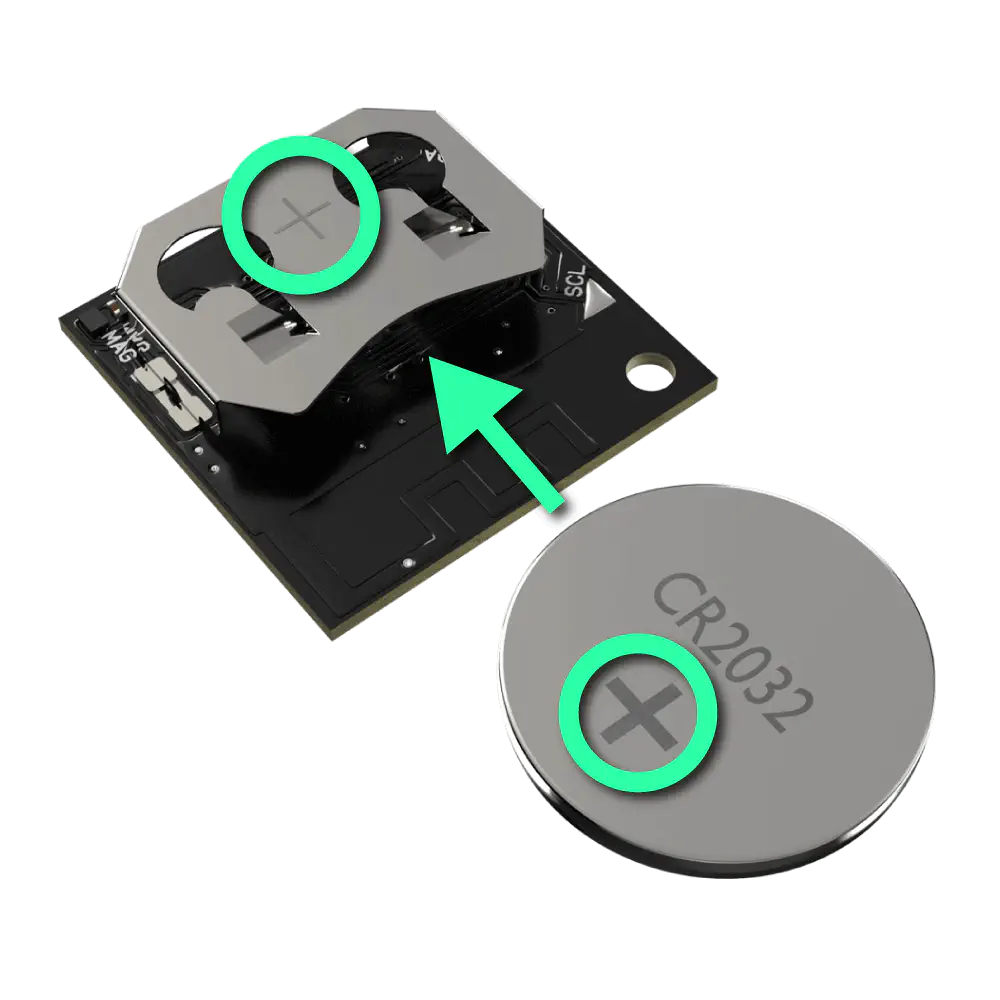
Battery Installation
Also, because the battery holder of TWELITE ARIA is structurally prone to solder joint detachment, please be careful when inserting the battery as follows:
- When removing the coin battery, it is recommended to lightly press the battery holder from above with your finger to reduce force on the solder joints while removing the coin battery.
- When using TWELITE ARIA, it is recommended to use it with a dedicated case that presses the battery holder from above.
Attach Fixing Magnet
By attaching a magnet to the recess at the position shown in the figure, you can stick TWELITE ARIA to a metal surface. Use as needed.
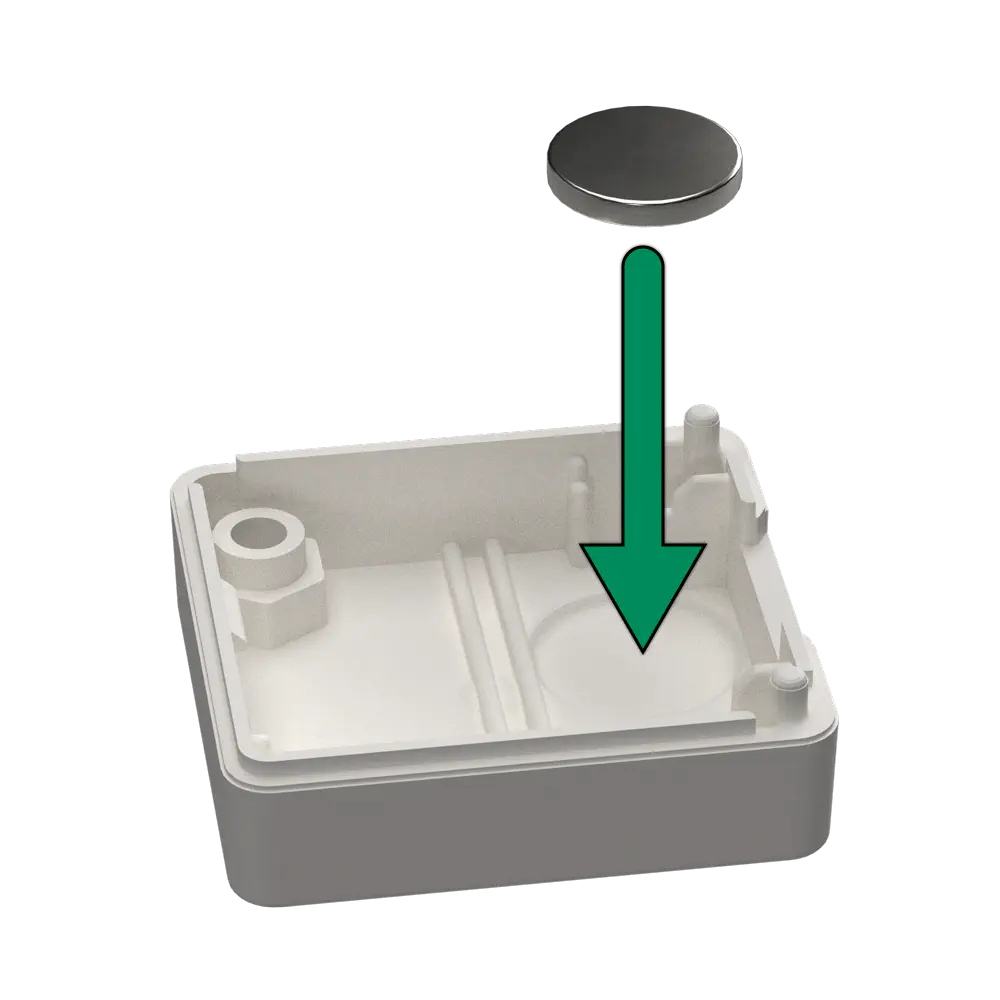
Magnet Installation Location
Insert into Case
Hook the board on the claws on the edge of the case as indicated by the circle marks.
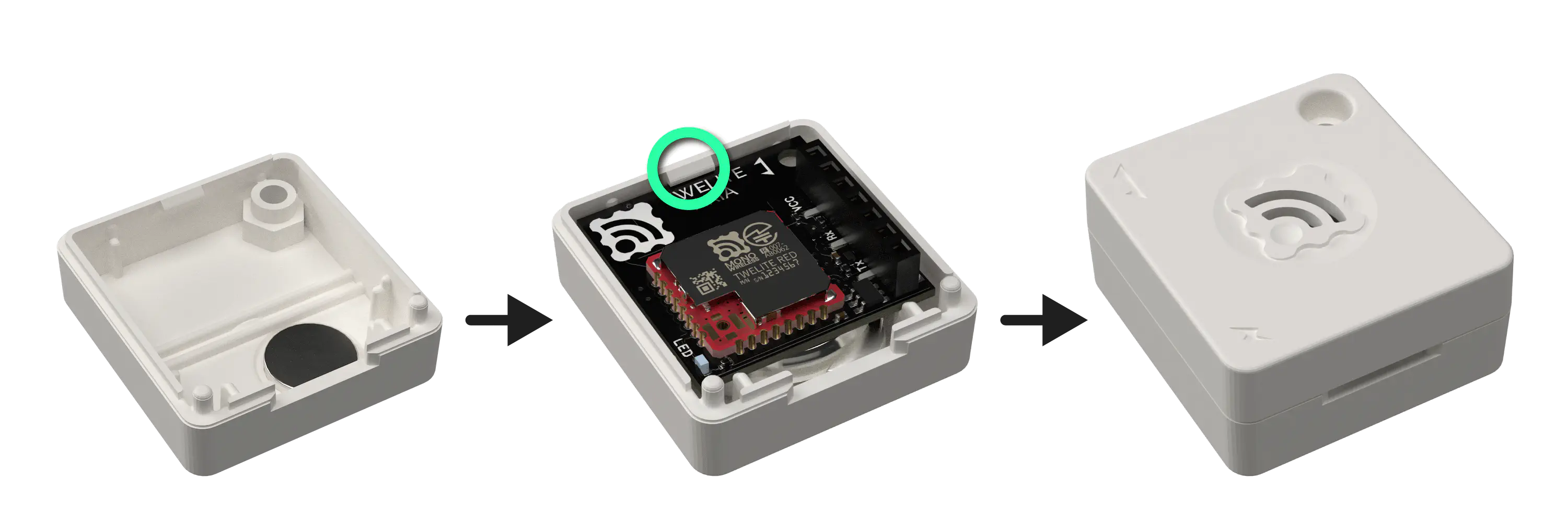
Inserting the Board
Open the Case
Insert a coin into the notch on the case and pry it open.
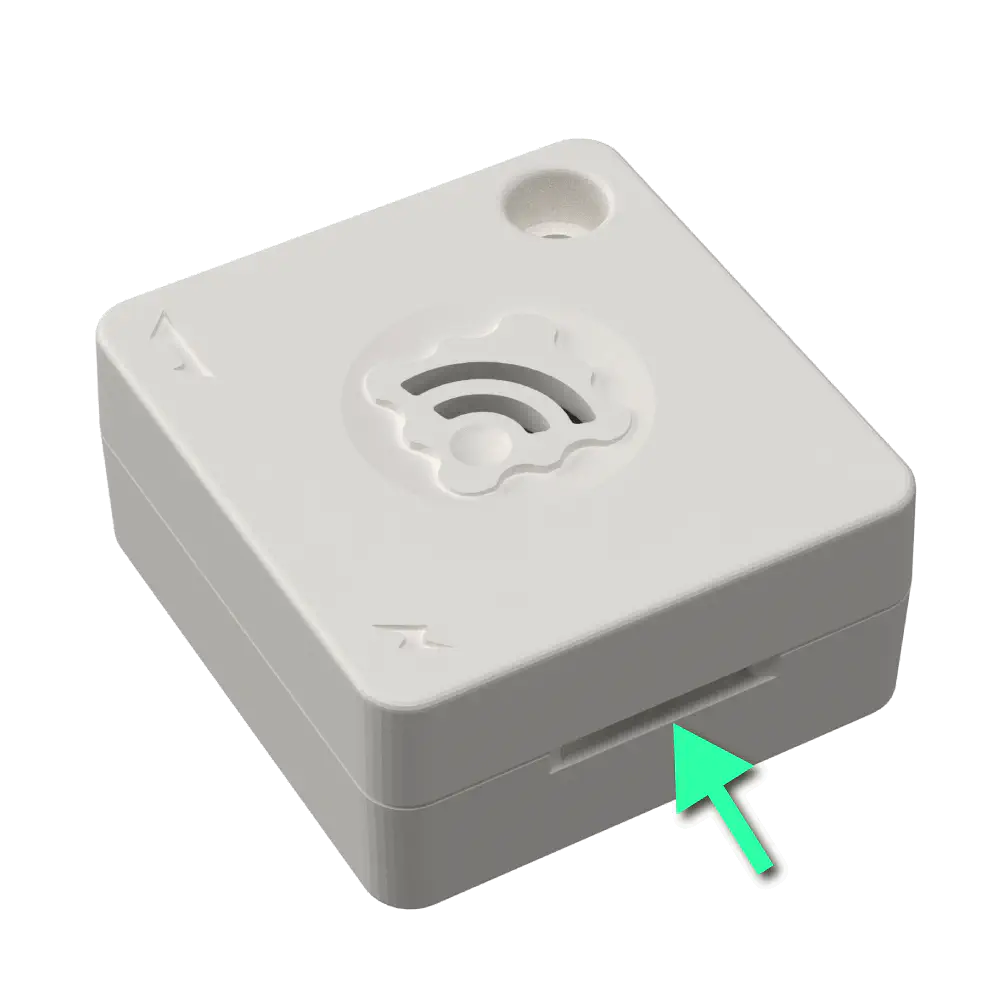
Where to Insert the Coin
Prepare Parent and Repeater
A parent device is required as a communication partner. If you want to extend communication distance, a repeater can be used. You can use MONOSTICK - MonoStick as the parent and repeater devices.
Please write the app version v1-01-4 or later of the Parent/Repeater App Wings to MONOSTICK - MonoStick.
Check Operation
Try moving the TWELITE ARIA or bringing a magnet close, and check the data received by the MONOSTICK connected to the PC.
Prepare TWELITE STAGE SDK
First, install the latest version of TWELITE STAGE SDK on your PC.
Launch TWELITE STAGE APP
- Connect MONOSTICK to the USB port of your PC.
- Double-click the following files inside the MWSTAGE folder of the installed TWELITE STAGE SDK.
・TWELITE_stage.exe (Windows)
・TWELITE_stage.command (macOS)
・TWELITE_stage.run (Linux)
When launched, the MONOSTICK connected via USB will be displayed on the screen. - Select 1: MONOSTICK from the serial port selection screen.
- When the device is selected, the top menu screen of TWELITE STAGE APP will be displayed.
Prepare Parent Device
A parent device is required as a communication partner. You can use MONOSTICK - MonoStick as the parent device.
Please write the Parent/Repeater App Wings to MONOSTICK - MonoStick following the steps below.
- From the top menu, select 2: Rewrite App > 1: Select from BIN.\
- If you are using MONOSTICK BLUE, select App_Wings_MONOSTICK_BLUE_…, and if you are using MONOSTICK RED, select App_Wings_MONOSTICK_RED_…
- After writing is complete, do not enter interactive mode; press and hold the ESC key to return to the top menu.
Select Viewer
- From the top menu, select 1: Viewer > 4: CUE/ARIA Viewer.
- Click the TWELITE ARIA tab.
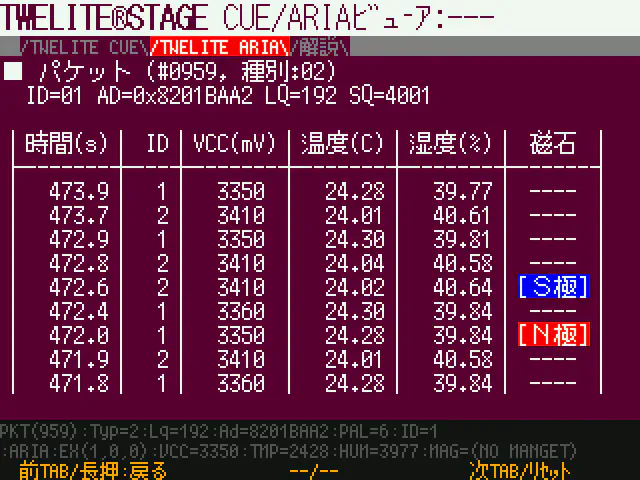
TWELITE ARIA Viewer
Check Operation of TWELITE ARIA
Measure Temperature and Humidity
Temperature and humidity values are updated every 5 seconds.
Detect Magnet
- When the N pole of a magnet is brought close to the magnetic sensor, “[N pole]” is displayed.
- When the S pole of a magnet is brought close to the magnetic sensor, “[S pole]” is displayed.
- When the magnet is moved away from the magnetic sensor, “ —- ” is displayed.
Change Mode
You can change the behavior of TWELITE ARIA by changing the mode.
Please refer to the following page for details.
Change Settings
You can set grouping and transmission frequency changes in interactive mode.
Please refer to the following page for how to enter interactive mode.
Also, please refer to the following page for the items that can be set.
Output Log
You can output data such as temperature and humidity in CSV format to a log using pulse scripts.
Please refer to the following page for details.
Draw Graph
You can view temperature, humidity, and magnetic sensor values as graphs using the PalViewer.
Please refer to the following page for details.
1.1.2 - Aria App Operating Modes
TWELITE ARIA mode
Initial mode of TWELITE ARIA.
An all-in-one mode that can measure temperature and humidity and detect door opening and closing simultaneously.
Open/Close Sensor Pal mode
Mode that operates as an open/close sensor pal.
Use this mode to measure door opening/closing or factory equipment operation status.
1.1.2.1 - Aria App TWELITE ARIA Mode
This mode is set as the factory default.
Settings
If you use this mode, please set the following items.
| Setting Command | Setting Item | Setting Value | Remarks |
|---|---|---|---|
| p | Sensor-specific parameter setting | 00000000 |
Parent Device Output
Typical Battery Life
- About 340 days if only periodic transmission every 5 seconds
- About 300 days if periodic transmission every 5 seconds plus magnet approached every 1 minute
- About 4 years if only periodic transmission every 1 minute
- About 2.5 years if periodic transmission every 1 minute plus magnet approached every 1 minute
1.1.2.2 - Aria App Open/Close Sensor Pal Mode
Settings
When using this mode, set the following items.
| Setting Command | Setting Item | Setting Value | Remarks |
|---|---|---|---|
| p | Sensor-specific parameter setting | 04000000 |
Parent Device Output
Typical Battery Life
Approximately 4 years if 200 open/close operations per day (including 1-minute periodic transmissions).
Approximately 4.5 years if 0 open/close operations per day (including 1-minute periodic transmissions).
1.2 - Aria App Settings
There are two ways to configure the Aria app.
For details on configurable items, please check Interactive Mode.
Configuration via OTA
OTA stands for Over the Air, meaning wireless communication. OTA configuration is a feature to configure settings without cable connection using Interactive Mode.
Executing OTA requires MONOSTICK.
Configuration using TWELITE R2
It is also possible to connect TWELITE R2/R3 to the 7P interface of TWELITE CUE and configure settings via Interactive Mode.
1.2.1 - OTA Settings for Aria App
OTA settings is a function to perform interactive mode settings via wireless communication.
Procedure for OTA Settings
Perform OTA settings following the steps below.
1. Launch the TWELITE STAGE APP
Install the TWELITE STAGE SDK on your PC, then launch TWELITE_Stage in the MWSTAGE folder.
2. Write the OTA setting app to MONOSTICK
Open 2: Rewrite App > 1: Select from BIN and select App_ARIA_OTA_....
3. Enter setting values in interactive mode
Select 3: Interactive Mode, then edit and save the values.
4. Execute OTA setting
Place the TWELITE ARIA within about 20 cm from MONOSTICK. Turn on the power of the device or bring a magnet close to the magnetic sensor more than 5 times, and confirm that the LED of TWELITE ARIA blinks.
5. Check the output of MONOSTICK
Confirm the output of messages like the following.
If no output is shown, see here.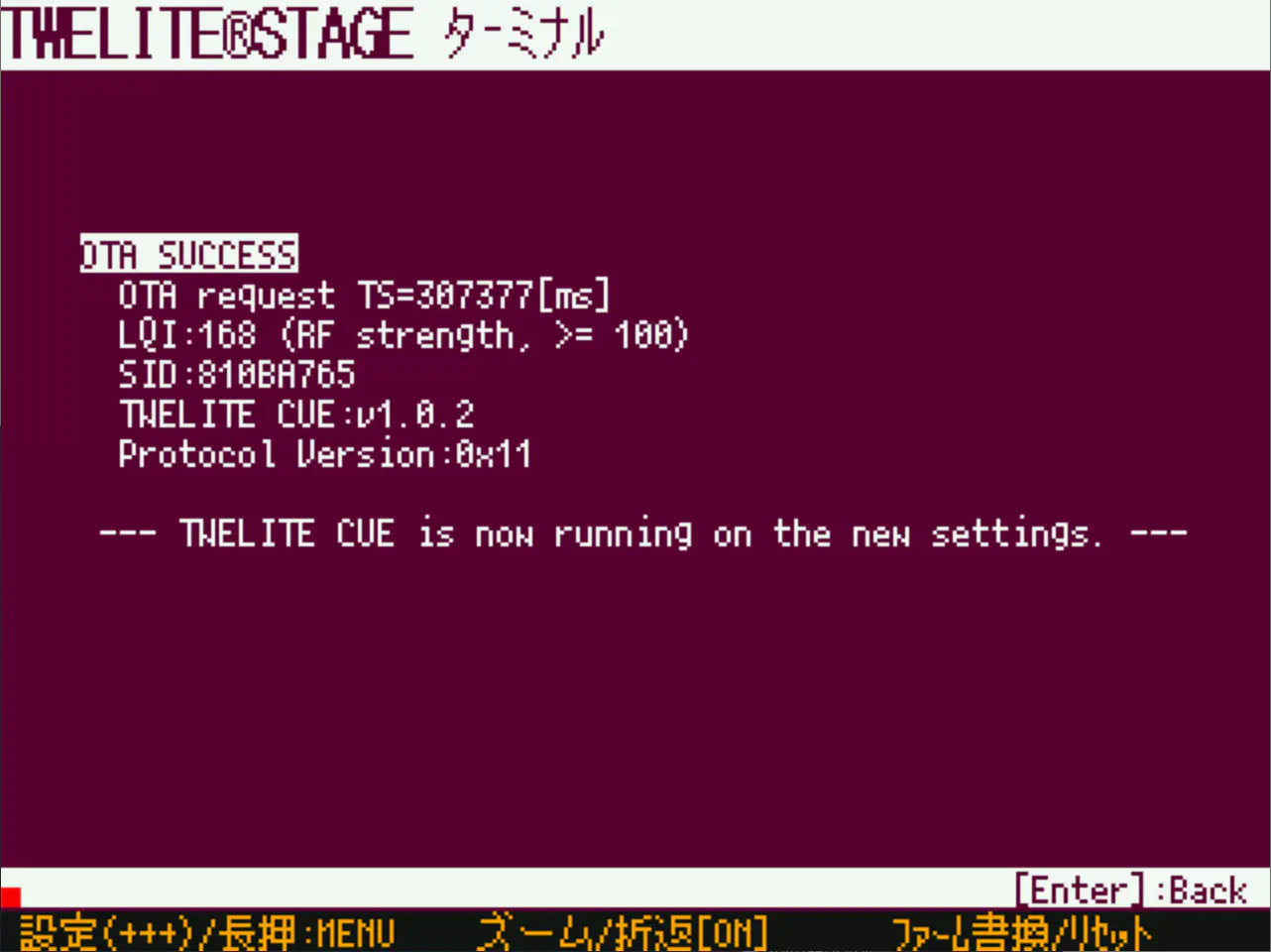
6. Write back the app to MONOSTICK
Open 2: Rewrite App > 1: Select from BIN and select App_Wings_MONOSTICK_....
If OTA Fails
Distance is too far
Messages like the following indicate that the distance is too far.
OTA FAILURE
OTA request TS=20515[ms]
LQI:63 (RF strength, >= 100)
SID:810BA765
TWELITE ARIA:v1.1.1
Protocol Version:0x13
--— LQI is small. Please make TWELITE ARIA closer. —--
In this case, bring MONOSTICK and TWELITE ARIA closer.
Different target
Messages like the following indicate that the firmware of TWELITE ARIA is different or that TWELITE CUE was mistakenly brought close.
OTA FAILURE
OTA request TS=20515[ms]
LQI:180 (RF strength, >= 100)
SID:810BA765
TWELITE ARIA:v1.1.1
Protocol Version:0x11
--— Different protocol version. Please update TWELITE ARIA. —--
In this case, check if you mistakenly brought TWELITE CUE close.
Also, if you rewrote the firmware of TWELITE ARIA, please use TWELITE R2/R3 to write back to App_ARIA.
1.2.2 - Settings for Aria App using TWELITE R2/R3
Settings can be made by connecting TWELITE R2/R3 to the 7P interface of TWELITE ARIA.
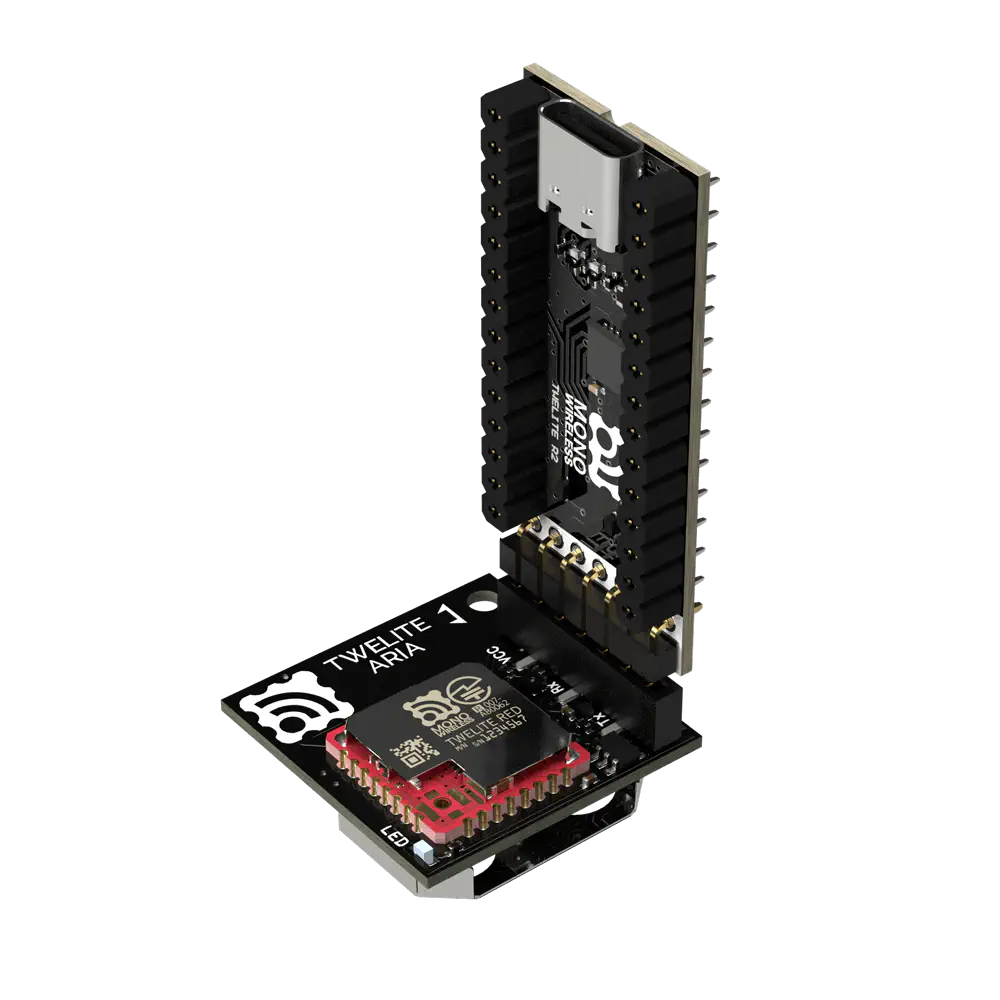
Example connection with TWELITE R2
When using TWELITE R2/R3 to configure, please follow the steps below.
1. Launch the TWELITE STAGE APP
Install the TWELITE STAGE SDK on your PC and launch TWELITE_Stage in the MWSTAGE folder.
2. Enter setting values in Interactive Mode
Select 3: Interactive Mode, then edit and save values.
1.3 - Interactive Mode (ARIA App)
This section explains features specific to the ARIA app (App_ARIA). For common features, please refer to the TWELITE APPS Manual Top Page.
Interactive mode cannot be used while TWELITE is in sleep mode.
Please start up with the SET pin connected to GND. The TWELITE STAGE app and TWELITE R2/R3 automatically perform this operation.
Example Display
The screen will display as follows:
--- CONFIG/App_ARIA V1-01-0/SID=0x810a7817/LID=0x01 ---
a: set Application ID (0x67720102)
i: set Device ID (--)
c: set Channels (18)
x: set Tx Power (13)
b: set UART baud (38400)
B: set UART option (8N1)
k: set Enc Key (0xA5A5A5A5)
o: set Option Bits (0x00000001)
t: set Transmission Interval (5)
p: set Senser Parameter (0x00000000)
d: set Temperature Coefficient (0)
D: set Temperature Offset (0)
f: set Humidity Coefficient (0)
F: set Humidity Offset (0)
---
S: save Configuration
R: reset to Defaults
Commands
| Setting Item | Default Value | Remarks | |
|---|---|---|---|
a | Application ID | 0x67720102 | 32bit |
i | Logical Device ID | - | Child device 1-100 |
c | Frequency Channel | 18 | 11-26 |
x | Retransmission Count and Transmission Power | 13 | |
| Retransmission Count | 1 | 1-9 times, 0 means none | |
| Transmission Power | 3 | 0-3 | |
b | 38400 | Not applicable | |
B | 8N1 | Not applicable | |
k | Encryption Key | 0xA5A5A5A5 | 32bit |
o | Option Bits | 0x00000001 | Other detailed settings |
t | Transmission Interval | 5 | 1-4095 seconds |
p | Sensor Specific Parameter | 0 | |
d | Temperature Coefficient | 0 | 0-60000 |
D | Temperature Offset | 0 | -2000-2000 |
f | Humidity Coefficient | 0 | 0-60000 |
F | Humidity Offset | 0 | -2000-2000 |
Details of each command are shown below.
a: Application ID
All devices communicating must have the same value. This logically separates the network.
i: Logical Device ID
Set this when it is necessary to identify multiple child devices.
You can set any value from 1 to 100.
c: Frequency Channel
All devices communicating must have the same value. This physically separates the network.
x: Transmission Power and Retransmission Count
Specify the radio transmission power and the number of times to retransmit packets additionally in transparent mode and header-attached transparent mode.
b: UART Alternative Baud Rate
Not applicable. Unlike products such as TWELITE DIP, there is no BPS pin.
B: UART Option
Not applicable. Unlike products such as TWELITE DIP, there is no BPS pin.
k: Encryption Key
Specify the encryption key as a 32bit hexadecimal number when enabling encryption communication with the option bit Enable Encryption Communication.
o: Option Bits
Specify a 32bit number. You can enable settings associated with each bit.
| Target Bit | Setting Item | Default |
|---|---|---|
0x00000001 | Enable Transmission to Relay Devices | 1️⃣ |
0x00000040 | Disable OTA Setting Function | 0️⃣ |
0x00001000 | Enable Encryption Communication | 0️⃣ |
0x00010000 | Enable UART Output on Child Device | 0️⃣ |
t: Transmission Interval
Specify the data transmission interval.
p: Sensor Specific Parameter
Used to switch the Operating Mode.
p | Mode |
|---|---|
0x00000000 | TWELITE ARIA Mode |
0x04000000 | Open/Close Sensor PAL Mode |
d: Temperature Coefficient
Specify the coefficient \(d\) of temperature data in the range 0-60000.
If 0, it is disabled. Otherwise, the final temperature is multiplied by \(\frac{d}{1024}\).
D: Temperature Offset
Specify the temperature data offset \(D\) in the range -2000 to 2000.
Add \(D\) to the temperature multiplied by 100. The final temperature changes by \(\frac{D}{100}\) °C.
f: Humidity Coefficient
Specify the coefficient \(f\) of humidity data in the range 0-60000.
If 0, it is disabled. Otherwise, the final humidity is multiplied by \(\frac{f}{1024}\).
F: Humidity Offset
Specify the humidity data offset \(F\) in the range -2000 to 2000.
Add \(F\) to the humidity multiplied by 100. The final humidity changes by \(\frac{F}{100}\) %.
Details of Option Bits
Explanation of settings associated with each bit of the option bit value.
00000001: Enable Transmission to Relay Devices
Enable transmission not only to the parent device but also to relay devices.
You can use relay devices even if this option is not set, but the parent device will eliminate duplicate packets received. At this time, there is no way to know through which relay device the packet was transmitted or if it was not relayed.
If this option is set, the parent device can output a single packet received from multiple devices separately. By analyzing the output connected to the parent device, you can determine near which device the child device was located.
00000040: Disable OTA Setting Function
Disables the OTA setting function.
00001000: Enable Encryption Communication
Enables encrypted communication. The other party must also enable encrypted communication.
00010000: Enable UART Output on Child Device
Enables message output on the child device.